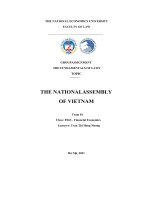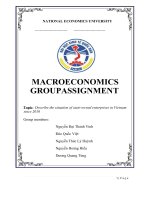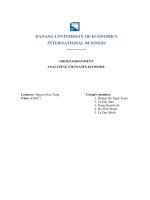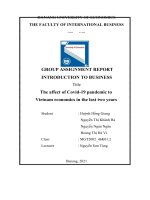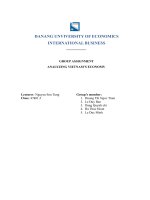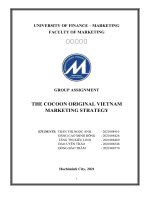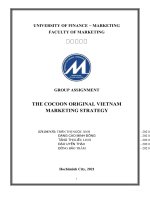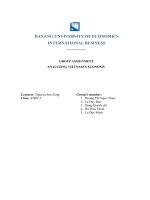group assignment the suntory pepsico vietnam beverage company spvb
Bạn đang xem bản rút gọn của tài liệu. Xem và tải ngay bản đầy đủ của tài liệu tại đây (2.32 MB, 14 trang )
<span class="text_page_counter">Trang 1</span><div class="page_container" data-page="1">
GROUP ASSIGNMENT
Group 3 Ho Chi Minh, July 2022
Course: ECO102
Lecturer: Nguyen Thi Thanh Nhan Class: HM1603
Group members: Nguyen Hai Long SA150020
</div><span class="text_page_counter">Trang 3</span><div class="page_container" data-page="3">1.Introduction
VNR500 rating 62(B1/2021)Stock code chưa niêm yết
Head office 88 Đồng Khởi Phường Bến , Nghé, Quận 1 TP Hồ Chí Minh
</div><span class="text_page_counter">Trang 4</span><div class="page_container" data-page="4">2. Body
2.1 Total asset and total employee
According to Ahn, D.H., Conrad, J., and Dittmar (2009), an asset is a resource with monetary value that an individual, corporation, or country owns or controls with the expectation of future benefit. Specifically, Pepsico company’s net revenue worldwide from 2020 to 2021 still increase by about 9.1 percent, indicating that the company also generates economic profits. However, due to the Covid-19 pandemic, the total assets have decreased by about 541 million dongs between 2020 and 2021 (Annual Report 2021).
In terms of total labor, PepsiCo had 309,000 employees in 2021, a 6.19 percent increase from 2020. In 2020, PepsiCo had 291,000 employees, an increase of 8.99 percent from 2019. Enterprises create jobs by education levels and capabilities. Company policies are always towards the benefit of employees and employees. reasonable salary structure and many activities to ensure health and safety such as periodical medical examination, working environment measures, provision of personal protective equipment, compulsory insurance on labor, and a safe working environment. Based on the total assets and labor of the company, it is possible to conclude that Pepsico is a very large company.
</div><span class="text_page_counter">Trang 5</span><div class="page_container" data-page="5">(Source: Statista) Figure 2.1.1: PepsiCo's number of employees from 2013 to 2021
(Source: Statista) Figure 2.1.2: PepsiCo’s net revenue worldwide from 2007 to 2021.
</div><span class="text_page_counter">Trang 6</span><div class="page_container" data-page="6">Table 2.1.1: Table of assets
(Source: Annual report 2021)
</div><span class="text_page_counter">Trang 7</span><div class="page_container" data-page="7">2.2 Organization structure
Pepsico changes its organizational structure on a regular basis in order to align its business operations with the dynamic business environment in the global beverage and food industry. It currently has a hierarchical organizational structure. Gardner et al. (2013) observe that PepsiCo has a complex organizational structure comprised of functional corporate groups and market divisions. Pepsico's organizational structure is comprised of three major characteristics: market divisions, functional corporate groups, and a global hierarchy.
This organizational structure feature of PepsiCo refers to basic business functions. For these functions, the company has global or corporate offices. The goal of functional groups at PepsiCo is to ensure corporate control and rapid implementation of policies and strategies. Each of these groups is led by an Executive Vice Director or a Senior Vice Director.
(Source: tutlance.com) Figure 2.2.1: PepsiCo’s management structure
</div><span class="text_page_counter">Trang 8</span><div class="page_container" data-page="8">2.3 Business sectors
PepsiCo is a large corporation that produces a variety of beverages such as water, carbonated drinks, fruit juice, sports drinks, and tea under the brands Pepsi, Lays, Tropicana, and Aquafina. To find out which economic sector PepsiCo belongs to, we based on business operations and product production. Pepsico has a long history of development and has created numerous food and beverage products. Pepsico not only has participated in Vietnam, but also in many other countries throughout the Americas, Europe, and other regions. Thereby, we see that PepsiCo is an enterprise with a large scale of operation and production. Pepsico belongs to the secondary sector, as evidenced by the company's growth and significant investment in production activities.
2.4 Demand and Supply
Vietnam is seeing a mid-single-digit fall in beverage unit volume. The COVID-19 pandemic played a part in a decline in consumer demand, which was detrimental to the expansion of beverage unit volume.
The inability of consumers to buy our products because of disease, quarantine or other limitations, store closures, or financial difficulty, are only a few of the changes in consumer demand brought on by COVID-19. Changes in consumer preferences for products and distribution channels, notably a rise in e-commerce demand, have affected and may continue to affect sales and profitability. Customers' financial situations may be negatively impacted by decreased demand for the items, changes in consumer buying habits, and ongoing economic instability, which may lead to bankruptcy filings or the inability to pay for the products. As a result of COVID-19, businesses may also experience temporary closures of their own or their partners' facilities, as well as the unavailability of a sizable number of their workforce to work due to illness, quarantine, travel, or other regulatory limitations. Any significant ongoing shortage of raw materials or other supplies, including personal protective equipment or sanitization products, or any sustained interruption in our or our business partners' operations, distribution network, or supply chain could have a negative effect on the company's operations. If the crisis management strategies do not successfully address these problems, business
</div><span class="text_page_counter">Trang 9</span><div class="page_container" data-page="9">operations may be disrupted by natural disasters or other uncontrollable occurrences that might severely affect product supply and diminish demand for the items.
2.5 Shortage or surplus
Table 2.5.1: Consolidated Net Revenue and Operating Profit
(Source: Annual report 2021) Operating profit fell by 2%, while the operating profit margin shrank by 1%. Certain operational cost increases, which were largely offset by net revenue growth and efficiency gains, were the main factor driving operating profit performance.
The COVID-19 pandemic had a negative 7 percentage point effect on operating profit performance, which is why the charges were made. For more details, please refer to Note 1 to our consolidated financial statements. The performance of operating profit was further negatively impacted by 2 percentage points by higher inventory fair value adjustments, merger and integration expenses contained in "Items Affecting Comparability," and unfavorable foreign exchange.
Operating profit improved by 24%, mostly as a result of net revenue growth, productivity gains, and a 10-point reduction in restructuring and impairment charges. However, these gains were partially offset by higher advertising and marketing costs as well as certain operating cost increases.
</div><span class="text_page_counter">Trang 10</span><div class="page_container" data-page="10">2.6 Revenue, Cost, Profit
Table 2.6.1: Consolidated Statement of Income PepsiCo, Inc, and Subsidiaries (in millions except per share amounts)
(Source: Annual report 2021)
According to the annual report of Pepsico, the total revenue in 2021 is $79,474 million. Although in 2021 the whole world is still affected by the covid pandemic, the revenue of PepsiCo has a revenue increase rate of nearly 3 times compared to the revenue increase rate from 2019 to 2020 PepsiCo's annual revenue for 2020 was $70,372 million. So revenue in 2021 increased by 12.93% compared to 2020. Pepsico's revenue was $67,161 million, an increase of 4.78% compared to 2019.
PepsiCo's total cost history and growth rate from 2011 through 2021. The difference between the beginning and ending inventories for tangible things results in an expense that represents manufacturing and sales expenses, which is described as cost. PepsiCo's annual cost of goods sold in 2021 was $37,075 million, $31,797 million in 2020, and $30,132 million in 2019. Compared to 2020, the total costs in 2021 increased by 16.6%. Compared to 2019, the total cost in 2020 increased by 5.53%. So the rate of increase in 2021 is 3 times higher than in 2020. Pepsico's annual report for 2021 shows that Pepsico's profit in 2020 is 38,575 million, a very slight increase compared to 2019 with a profit of 37,029 million. We can see that the profit of 2020 only increased by 4.17% compared to 2019. The reason is due to the impact of the covid-
</div><span class="text_page_counter">Trang 11</span><div class="page_container" data-page="11">19 epidemic, the disease has caused the whole world's economy to stall. It affects Pepsico's business. However, in 2021, the economy starts to reopen, so Pepsico's profit is 42,399 million, an increase of 9.91% compared to 2022. We can see that the growth rate of 2021 is more than double the growth rate of the year 2019.
2.7 Competitors
Long is regarded as a fruitful place for numerous "giants" to roam, Vietnam's beverage and soft drink market. Coca-Cola, Pepsi, Tribeca, Tan Hiep Phat, URC, Wonderfarm, etc. are a few well-known brands. However, because of their well-known brands and extensive histories, Pepsi and Coca-Cola are presently nearly dominating the domestic beverage industry in Vietnam.
The Vietnamese market is experiencing extremely severe competition from indigenous soft drink producers in addition to Coca-Cola and Pepsi, as well as a variety of strategies to gain market share. Tan Hiep Phat Company introduced Product Number 1 in 2001 to compete in the energy drink industry. At that time, this segment was being stormed by Red Bull, Rhino, and Lipovitan.
Pie chart of VietNam beverage market share
(source: vuaphache.net)
</div><span class="text_page_counter">Trang 12</span><div class="page_container" data-page="12">2.8 Market structure
Pepsico is a good example of an oligopoly. Pepsico operates in an oligopolistic market. They are trading on products that they can control the price and also consider actions and reactions to competitors; when they consider changing the product price, they always change the price of the product according to the price of a competitor.
2.9 Macroenvironment _ PESTLE framework
Political
Due to globalization, Vietnam has expanded its policy, including benefits for investment by international companies, to attract global brands and international brands to reach the market. Franchising is the way Pepsico, which is the name of the company that owns the Pepsi brand, uses it to enter the Vietnamese market. Vietnam is a country with a stable political situation, so this is a market where Suntory PepsiCo has invested effectively and built a sustainable reputation.
Economical
Vietnam is a developing country, and the figures show that Vietnamese people's income has increased steadily over the past decade, which presents a profitable picture for one of the oldest established brands in the beverage industry. 2020 is the year the whole world suffers from crises due to the covid pandemic, but Vietnam's GDP is increasing. Vietnam is one of the potential markets in Asia for the expansion and strengthening of Pepsi's brand identity. Social
A healthy living culture that cares about the health of Vietnamese people, brings negative effects to Pepsico. Consumers focus more on health and choose a healthy lifestyle, which means they will choose healthy products. And this leads to a significant reduction in the purchase of soft drinks and water is the choice of consumers.
</div><span class="text_page_counter">Trang 13</span><div class="page_container" data-page="13">Technological
Today, Vietnam's technology is developing and becoming more and more advanced, so Pepsico has innovated and applied technology to its production process. They have a production line with many high-tech machines that can guarantee the quality of each product unit.
Legal
PepsiCo must follow government regulations and tax laws to remain profitable. Vietnam has a lot of laws to protect both sellers and consumers. Therefore, the company must comply with such regulations as the law on food safety and hygiene.
Environmental
Pollution makes us think about how to protect nature and Vietnam is no exception. For Pepsico bottles and cans, they have introduced a recycling process for them. From there, it helps to limit non-biodegradable waste, in addition, they also offer a number of activities to encourage environmental protection.
3. Conclusion
Food and beverages from all over the world can now enter the Vietnamese market, and Pepsico has developed its own identity to maintain its market share. Simultaneously, the opening of low raw material prices can be an opportunity to expand market share. With the beer market's growth rate, Pepsico, along with foresight and quick thinking to adapt to new things, will go further and further, reap more successes, and ignite Vietnam's aspiration and pride.
</div><span class="text_page_counter">Trang 14</span><div class="page_container" data-page="14">Pepsi Market Structure - 1063 Words | Internet Public Library. (n.d.). IPL.org. Retrieved July 20, 2022, from Phan, V. L. 2019, November 25. Cuộc chiến thương hiệu đồ uống tại Việt Nam. Phan Law Vietnam.
Ridder, M. 2022, April 8. PepsiCo number of employees worldwide, 2021. Statista. Retrieved July 20, 2022, from
Ridder, M. 2022, April 8. PepsiCo's net revenue worldwide, 2021. Statista. Retrieved July 20, 2022, from VietNam, P. L., 2019. phan.vn. [Online]
Available at: [Accessed 20 7 2022].
vuaphache. 2020. Thị Trường Nước Giải Khát Việt Nam & Số Liệu Thống Kê Phân Tích. Vua Pha Chế.
</div>
